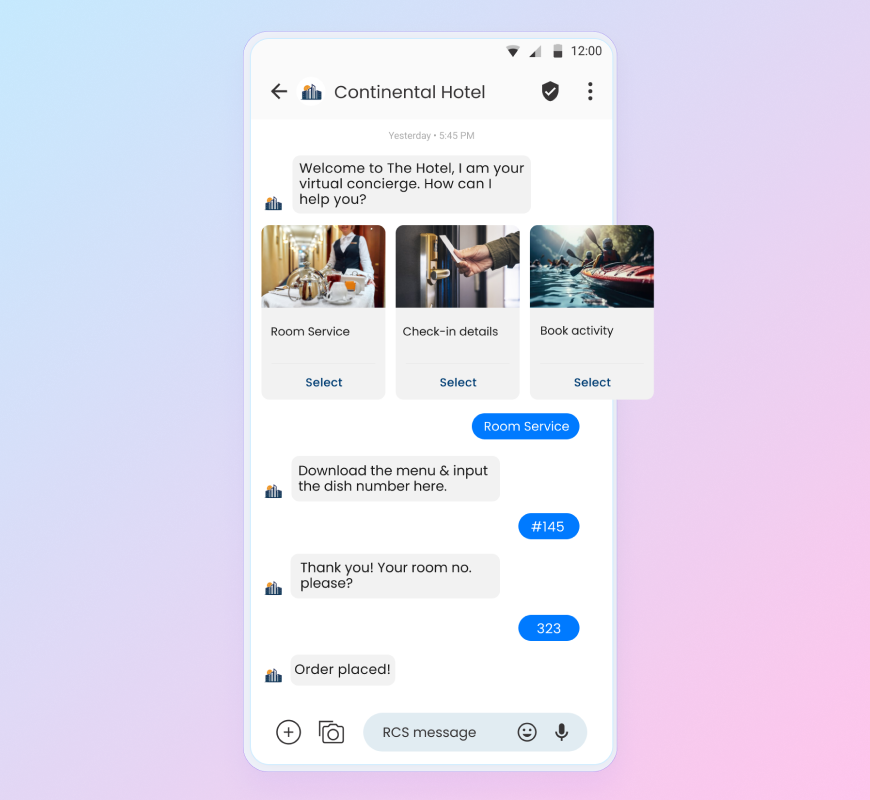Rich Communication Services (RCS) is transforming business messaging with interactive capabilities that go far beyond text. Yet many businesses hesitate to embrace this evolution. The challenge? How to justify investing in an emerging channel when SMS already delivers reliable results.
It’s not about replacing SMS, but strategically adding RCS capabilities to enhance customer engagement. This article explores practical approaches to build a compelling business case for RCS while maximizing its unique strengths alongside your existing messaging strategy.
Building a Compelling RCS Business Case Through Targeted Testing
Focus on High-Impact Use Cases First
The most successful RCS adopters begin with carefully designed pilot programs targeting specific scenarios where rich media and interactivity clearly outperform text-only alternatives.
Consider these high-impact use cases that deliver immediate value:
- Interactive Promotional Campaigns: Food delivery services have transformed standard discount offers into engaging experiences with RCS. Instead of sending a plain text “15% off your next order” message, they create interactive scratch cards revealing personalized offers, complete with mouth-watering food imagery and instant “Order Now” buttons. These immersive experiences have doubled engagement rates compared to traditional SMS campaigns.

- Virtual Product Demonstrations: Cosmetics retailers now send interactive makeup tutorials through RCS, allowing customers to see product application techniques and view different color options through rich carousels. These visual demonstrations create emotional connections impossible with text-only messages, resulting in significantly higher purchase intent.
- Location-Based Services: Hotels and resorts implement check-in facilitation through RCS by sending interactive maps with turn-by-turn directions, property layouts, and amenity information prior to guest arrival. By embedding one-tap access to essential information that would otherwise require app downloads or website visits, these businesses streamline the customer experience while capturing valuable interaction data.

Develop Better Measurement Frameworks
One key to overcoming ROI uncertainty is implementing precise measurement systems that isolate RCS impact from other marketing channels.
Effective measurement approaches include:
- Customer Journey Attribution: Brands have developed sophisticated attribution models tracking how RCS messages influence application completions. By implementing unique tracking parameters for each RCS interaction point (card carousel selection, calculator usage, appointment booking), they can identify which message elements drive conversions and optimize accordingly. These insights have enabled precise calculation of customer acquisition costs through the RCS channel.
- Conversion Path Analysis: Companies map the complete customer journey from initial RCS interaction to final booking, identifying exactly where rich experiences outperform traditional messaging. For instance, when sending vacation package promotions, they track which specific RCS elements (interactive resort tours, room upgrade options, or payment plan calculators) most effectively move customers toward purchase. This granular understanding allows marketers to justify additional RCS investment with concrete revenue impact data.
- Comparative Channel Testing: You can conduct controlled experiments by dividing customer segments between RCS and traditional channels for identical promotions. By maintaining consistent offers while varying only the delivery channel, you can isolate RCS’s specific impact on metrics like open rates, click-through rates, and conversion values. These controlled tests have demonstrated that RCS messages achieve 30-40% higher engagement for complex products that benefit from visual presentation and interactive elements.
Making RCS Implementation More Cost-Effective
Leverage Cloud-Based Integration
Modern messaging platforms dramatically reduce RCS deployment costs through cloud-native architectures. Businesses can minimize upfront investment by adding RCS capabilities to existing SMS infrastructure via API-based solutions, achieving full deployment in weeks while maintaining SMS fallback capabilities.
This approach transforms large capital expenditure into manageable operational costs, with pricing models that align expenses directly to engagement metrics.
Explore Performance-Based Pricing Models
Forward-thinking businesses negotiate performance-based contracts with RCS providers, tying a portion of platform fees to predefined KPIs like conversion rates or customer acquisition costs. This shared-risk model provides financial flexibility during the proof-of-value phase, making adoption more palatable to hesitant decision-makers.
Creating Hybrid Messaging Strategies
Implement Tiered Engagement Approaches
Smart businesses deploy decision engines that segment customers by device capability and engagement history:
- High-value customers receive RCS experiences with personalized offers and interactive elements
- Broader audience segments receive streamlined SMS for transactional alerts and time-sensitive information
This dual-channel strategy preserves SMS revenue while capturing RCS’s premium engagement benefits.
Develop Seamless Fallback Mechanisms
Technical frameworks ensuring smooth fallback from RCS-rich elements to SMS-compatible content prevent fragmented customer experiences. Systems that automatically convert product carousels to shortened URLs in SMS maintain message integrity across channels while eliminating duplicated content creation costs.
Accelerating Value Through Collaboration
Participate in Industry Standardization Efforts
Involvement in RCS standardization initiatives helps businesses reduce market-specific adaptation costs. Industry consortiums creating standardized taxonomy elements across RCS implementations have significantly lowered development expenses for participating companies.
Explore Partnerships with Technology Providers
Businesses can amplify RCS impact through joint campaigns with messaging app providers, gaining premium placement in RCS discovery feeds. These partnerships deliver significantly higher engagement compared to standalone deployments by leveraging platform-native user experience patterns.
Monetizing RCS’s Unique Capabilities
Enable Conversational Commerce
Embedding transaction capabilities within RCS flows creates entirely new revenue streams. Retailers enabling complete purchases via RCS chat—where users select products, apply promotions, and pay through saved credentials without leaving the conversation—report higher average order values and acquisition of new customers.
Implement Dynamic Pricing and Offers
Travel companies push fare alerts through RCS with one-click booking buttons, capturing price-sensitive travelers during critical decision windows. Machine learning algorithms optimize send times based on individual booking histories, yielding more upsells than traditional email campaigns.
Reframing the RCS Value Proposition
The RCS business case strengthens through layered strategies that reduce adoption risks while maximizing its differentiation from SMS. By focusing initial investments on high-return use cases, leveraging cloud economics, and participating in ecosystem standardization, businesses can achieve profitable RCS operations within 12-18 months.
Critical to success is positioning RCS not as an SMS replacement but as a premium engagement layer that coexists with SMS’s broad reach. With Apple’s recent RCS integration eliminating the last major compatibility barrier, RCS will soon transition from experimental pilot to essential communication channel.
For aggregators, ISVs, and developers, this presents an opportunity to become strategic partners by integrating Dotgo’s comprehensive RCS solution into existing services. As brands seek messaging partners who can deliver both SMS reliability and RCS innovation, offering enterprise-grade RCS capabilities through providers like Dotgo will become a decisive advantage in winning and retaining high-value clients.





